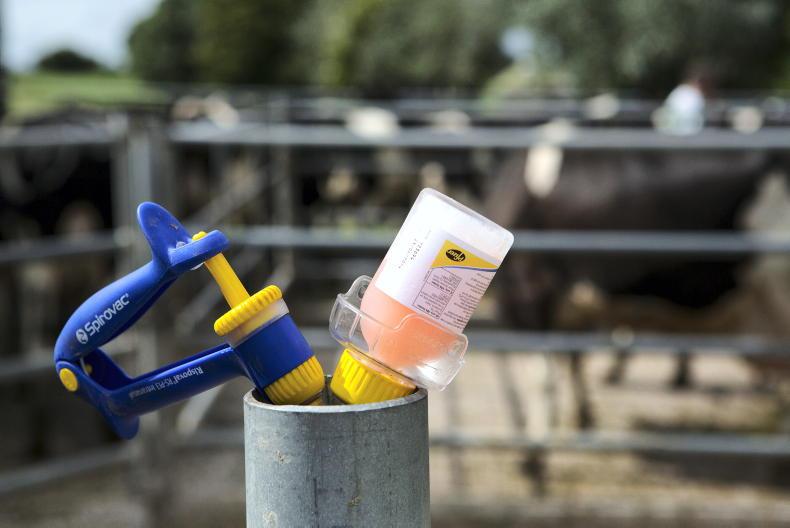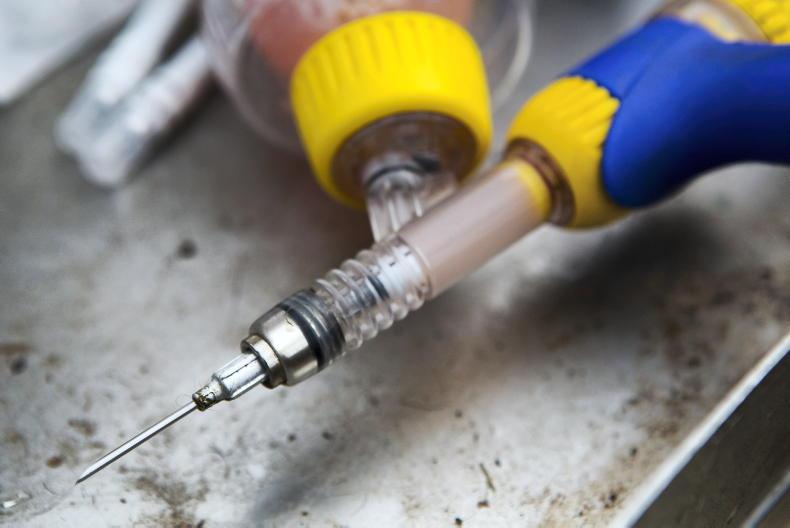Check pipes and water troughs for leaks and clean out the water troughs before letting stock out to grass. If buying new troughs, they should be at least 3ft off the ground or as high as practical or be designed, for example with sheer sides, to prevent badgers drinking from them. Mend any fences or gates that need repairs to avoid animals escaping.
Ensure all vaccinations are up to date ahead of the breeding season (lepto, IBR, BVD) and for calves, black leg and respiratory vaccines as recommended by your vet.
A dung sample from a group of animals before turnout can be useful to check whether your housing dose has been effective – liver fluke or worm eggs could indicate a need to review dosing at the next housing.
If a liver fluke treatment is needed, at this time of year a product that targets adult liver fluke will reduce egg contamination on pastures.
For gut worms, adult cattle do not usually need a treatment and calves that were born and raised indoors until now will be free of worms until they are released to pastures and do not need treatment at turnout.
Dairy calves should be closely monitored and might need treatment soon after turnout if a high parasite burden is expected on the pastures.
Pastures that were grazed in the previous season by calves might be at a high risk for this.
Speak to your vet about suitable products and optimum timings of treatments for parasites.
For farms with a history of lungworm, vaccinations can be an effective way of preventing outbreaks on the farm for animals over eight weeks old. The vaccine course requires two doses four weeks apart, and allow two weeks before turnout after the second dose. Wormers should not be used for a number of weeks after vaccination to allow immunity to develop.
Plan which animals would benefit from earlier grazing and turnout in groups, with lighter animals first and heavier animals when weather and soil conditions improve. Match the grass growth and, as it improves, turn out more animals.
Last year saw the first National Parasite Control TASAH programme for farmers and their vets. Over 16,000 farmers participated, taking advantage of a free veterinary consultation and two faecal egg counts for gut worms.
The programme is open again for 2023 and any cattle or sheep farmer in Ireland can take part, even if they participated last year. Farmers who haven’t registered previously can sign up on the AHI website.
Resistance to anthelmintics (wormers), particularly in sheep, is a growing concern in Ireland. The results from last year’s Parasite Control TASAH programme suggest that 28% of sheep farmers and 12% of cattle farmers feel that wormers are no longer as effective on their farms as they used to be.
By the time a farmer can see a clinical problem with the effectiveness of the wormers, then the resistance problem may be widespread on-farm and very difficult to manage.
It is the worms that develop resistance to the worming medicines and not the animals, so the first step is to do a drench test to see if the treatments used on farm are still killing the worms as expected.
This involves taking a dung sample from a group before treatment and seven to 14 days after treatment. Your vet can advise on the best timings and procedure to carry out this testing.
Delaying resistance
There are some methods to try to delay the development of wormer resistance on farm.
One important aspect is to make sure that treatments are being given correctly for the correct weight of the animal and that the dosing gun is giving out the expected volume of product.
If dosing a group of animals, place similar-sized animals together and dose to the heaviest animal in the group, not the average, to avoid under-dosing the heavier animals.
Another consideration is whether the animals actually need a dose for worms.
Adult cattle or sheep usually only need treatment for liver fluke and not for gut worms. Animals develop immunity to gut worms with exposure over time, so the youngest animals are most at risk of clinical disease from worms and should be monitored and treated when needed.
Calves and yearlings should be watched closely for coughing, particularly late in the grazing season, as this may be a sign of hoose (lungworm) but there are now cases reported more frequently in early spring as well.
March can be a very unsettled weather period and conditions can change very quickly. If cold sets in calves require 10% extra milk during the bad weather to make up for the energy needed to keep warm.Transitional milk needs to be kept out of the bulk tank for eight milkings – it can cause issues with milk processing and contaminants such as teat sealer can affect cheese production. For dairy calves, a dung sample from the group six to eight weeks after turnout is a good indicator of the burden of gut worms on the pasture and can help with dosing planning. Suckler cows that have been left out after calving might need access to an additional source of magnesium to prevent grass tetany. The obvious signs of grass tetany are twitching, staggering or collapsed animals – it can be fatal and the vet should be called as soon as possible if it is suspected. Continue to check calves regularly for any sign of ill health such as scours, joint ill or pneumonia. The sooner these are treated, the more likely the treatment will be successful.
Check pipes and water troughs for leaks and clean out the water troughs before letting stock out to grass. If buying new troughs, they should be at least 3ft off the ground or as high as practical or be designed, for example with sheer sides, to prevent badgers drinking from them. Mend any fences or gates that need repairs to avoid animals escaping.
Ensure all vaccinations are up to date ahead of the breeding season (lepto, IBR, BVD) and for calves, black leg and respiratory vaccines as recommended by your vet.
A dung sample from a group of animals before turnout can be useful to check whether your housing dose has been effective – liver fluke or worm eggs could indicate a need to review dosing at the next housing.
If a liver fluke treatment is needed, at this time of year a product that targets adult liver fluke will reduce egg contamination on pastures.
For gut worms, adult cattle do not usually need a treatment and calves that were born and raised indoors until now will be free of worms until they are released to pastures and do not need treatment at turnout.
Dairy calves should be closely monitored and might need treatment soon after turnout if a high parasite burden is expected on the pastures.
Pastures that were grazed in the previous season by calves might be at a high risk for this.
Speak to your vet about suitable products and optimum timings of treatments for parasites.
For farms with a history of lungworm, vaccinations can be an effective way of preventing outbreaks on the farm for animals over eight weeks old. The vaccine course requires two doses four weeks apart, and allow two weeks before turnout after the second dose. Wormers should not be used for a number of weeks after vaccination to allow immunity to develop.
Plan which animals would benefit from earlier grazing and turnout in groups, with lighter animals first and heavier animals when weather and soil conditions improve. Match the grass growth and, as it improves, turn out more animals.
Last year saw the first National Parasite Control TASAH programme for farmers and their vets. Over 16,000 farmers participated, taking advantage of a free veterinary consultation and two faecal egg counts for gut worms.
The programme is open again for 2023 and any cattle or sheep farmer in Ireland can take part, even if they participated last year. Farmers who haven’t registered previously can sign up on the AHI website.
Resistance to anthelmintics (wormers), particularly in sheep, is a growing concern in Ireland. The results from last year’s Parasite Control TASAH programme suggest that 28% of sheep farmers and 12% of cattle farmers feel that wormers are no longer as effective on their farms as they used to be.
By the time a farmer can see a clinical problem with the effectiveness of the wormers, then the resistance problem may be widespread on-farm and very difficult to manage.
It is the worms that develop resistance to the worming medicines and not the animals, so the first step is to do a drench test to see if the treatments used on farm are still killing the worms as expected.
This involves taking a dung sample from a group before treatment and seven to 14 days after treatment. Your vet can advise on the best timings and procedure to carry out this testing.
Delaying resistance
There are some methods to try to delay the development of wormer resistance on farm.
One important aspect is to make sure that treatments are being given correctly for the correct weight of the animal and that the dosing gun is giving out the expected volume of product.
If dosing a group of animals, place similar-sized animals together and dose to the heaviest animal in the group, not the average, to avoid under-dosing the heavier animals.
Another consideration is whether the animals actually need a dose for worms.
Adult cattle or sheep usually only need treatment for liver fluke and not for gut worms. Animals develop immunity to gut worms with exposure over time, so the youngest animals are most at risk of clinical disease from worms and should be monitored and treated when needed.
Calves and yearlings should be watched closely for coughing, particularly late in the grazing season, as this may be a sign of hoose (lungworm) but there are now cases reported more frequently in early spring as well.
March can be a very unsettled weather period and conditions can change very quickly. If cold sets in calves require 10% extra milk during the bad weather to make up for the energy needed to keep warm.Transitional milk needs to be kept out of the bulk tank for eight milkings – it can cause issues with milk processing and contaminants such as teat sealer can affect cheese production. For dairy calves, a dung sample from the group six to eight weeks after turnout is a good indicator of the burden of gut worms on the pasture and can help with dosing planning. Suckler cows that have been left out after calving might need access to an additional source of magnesium to prevent grass tetany. The obvious signs of grass tetany are twitching, staggering or collapsed animals – it can be fatal and the vet should be called as soon as possible if it is suspected. Continue to check calves regularly for any sign of ill health such as scours, joint ill or pneumonia. The sooner these are treated, the more likely the treatment will be successful. 








SHARING OPTIONS